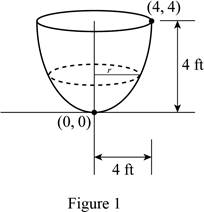
Concept explainers
(a)
To calculate: the work required to pump the water out of the tank.
(a)
Answer to Problem 29RE
The required work to pump the water out of the tank is
Explanation of Solution
Given information:
The shape of the tank is paraboloid.
Height of the tank is
Radius of the tank is
Weight density of water is
Calculation:
Sketch the parabolic shape tank for dimension as shown below:

Show the equation of parabola as shown below:
The radius of the cross section at y as follows:
Show the area of cross section as shown below:
Expression of volume at an equipotential in the gravitational field:
Express to find the mass as shown below:
Substitute
The distance of the layer each particle approximately
The work done
Expression to find the element of work:
Here, F is the force, and d is the distance.
Substitute
Express to find the total work as shown below:
Substitute 0 for a, 4 for b, and
Therefore, required work to pump the water out of the tank is
(b)
To find: the remaining depth of water in the tank after
(b)
Answer to Problem 29RE
The remaining depth of water in the tank after
Explanation of Solution
Given information:
The work done is
Calculation:
Apply the integral equation to find the remaining depth of water after 4000 ft-lb of work done.
Both sides divided by
Solving the Equation to get d.
The depth value of -1.5 ft is negative.
The depth value of 5.434 ft greater than the given depth value.
Therefore, the remaining depth of water in the tank after
Chapter 6 Solutions
Single Variable Calculus: Concepts and Contexts, Enhanced Edition
- Consider the following system of equations, Ax=b : x+2y+3z - w = 2 2x4z2w = 3 -x+6y+17z7w = 0 -9x-2y+13z7w = -14 a. Find the solution to the system. Write it as a parametric equation. You can use a computer to do the row reduction. b. What is a geometric description of the solution? Explain how you know. c. Write the solution in vector form? d. What is the solution to the homogeneous system, Ax=0?arrow_forward2. Find a matrix A with the following qualities a. A is 3 x 3. b. The matrix A is not lower triangular and is not upper triangular. c. At least one value in each row is not a 1, 2,-1, -2, or 0 d. A is invertible.arrow_forwardFind the exact area inside r=2sin(2\theta ) and outside r=\sqrt(3)arrow_forward
- A 20 foot ladder rests on level ground; its head (top) is against a vertical wall. The bottom of the ladder begins by being 12 feet from the wall but begins moving away at the rate of 0.1 feet per second. At what rate is the top of the ladder slipping down the wall? You may use a calculator.arrow_forwardExplain the focus and reasons for establishment of 12.4.1(root test) and 12.4.2(ratio test)arrow_forwarduse Integration by Parts to derive 12.6.1arrow_forward
- Explain the relationship between 12.3.6, (case A of 12.3.6) and 12.3.7arrow_forwardExplain the key points and reasons for the establishment of 12.3.2(integral Test)arrow_forwardUse 12.4.2 to determine whether the infinite series on the right side of equation 12.6.5, 12.6.6 and 12.6.7 converges for every real number x.arrow_forward
 Calculus: Early TranscendentalsCalculusISBN:9781285741550Author:James StewartPublisher:Cengage Learning
Calculus: Early TranscendentalsCalculusISBN:9781285741550Author:James StewartPublisher:Cengage Learning Thomas' Calculus (14th Edition)CalculusISBN:9780134438986Author:Joel R. Hass, Christopher E. Heil, Maurice D. WeirPublisher:PEARSON
Thomas' Calculus (14th Edition)CalculusISBN:9780134438986Author:Joel R. Hass, Christopher E. Heil, Maurice D. WeirPublisher:PEARSON Calculus: Early Transcendentals (3rd Edition)CalculusISBN:9780134763644Author:William L. Briggs, Lyle Cochran, Bernard Gillett, Eric SchulzPublisher:PEARSON
Calculus: Early Transcendentals (3rd Edition)CalculusISBN:9780134763644Author:William L. Briggs, Lyle Cochran, Bernard Gillett, Eric SchulzPublisher:PEARSON Calculus: Early TranscendentalsCalculusISBN:9781319050740Author:Jon Rogawski, Colin Adams, Robert FranzosaPublisher:W. H. Freeman
Calculus: Early TranscendentalsCalculusISBN:9781319050740Author:Jon Rogawski, Colin Adams, Robert FranzosaPublisher:W. H. Freeman
 Calculus: Early Transcendental FunctionsCalculusISBN:9781337552516Author:Ron Larson, Bruce H. EdwardsPublisher:Cengage Learning
Calculus: Early Transcendental FunctionsCalculusISBN:9781337552516Author:Ron Larson, Bruce H. EdwardsPublisher:Cengage Learning





